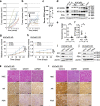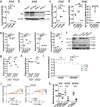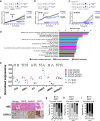Comprehensive genomics in androgen receptor-dependent castration-resistant prostate cancer identifies an adaptation pathway mediated by opioid receptor kappa 1
- PMID: 35365763
- PMCID: PMC8976065
- DOI: 10.1038/s42003-022-03227-w
Comprehensive genomics in androgen receptor-dependent castration-resistant prostate cancer identifies an adaptation pathway mediated by opioid receptor kappa 1
Erratum in
-
Author Correction: Comprehensive genomics in androgen receptor-dependent castration-resistant prostate cancer identifies an adaptation pathway mediated by opioid receptor kappa 1.Commun Biol. 2022 Jul 19;5(1):718. doi: 10.1038/s42003-022-03707-z. Commun Biol. 2022. PMID: 35854103 Free PMC article. No abstract available.
Abstract
Castration resistance is a lethal form of treatment failure of prostate cancer (PCa) and is associated with ligand-independent activation of the androgen receptor (AR). It is only partially understood how the AR mediates survival and castration-resistant growth of PCa upon androgen deprivation. We investigated integrative genomics using a patient-derived xenograft model recapitulating acquired, AR-dependent castration-resistant PCa (CRPC). Sequencing of chromatin immunoprecipitation using an anti-AR antibody (AR-ChIP seq) revealed distinct profiles of AR binding site (ARBS) in androgen-dependent and castration-resistant xenograft tumors compared with those previously reported based on human PCa cells or tumor tissues. An integrative genetic analysis identified several AR-target genes associated with CRPC progression including OPRK1, which harbors ARBS and was upregulated upon androgen deprivation. Loss of function of OPRK1 retarded the acquisition of castration resistance and inhibited castration-resistant growth of PCa both in vitro and in vivo. Immunohistochemical analysis showed that expression of OPRK1, a G protein-coupled receptor, was upregulated in human prostate cancer tissues after preoperative androgen derivation or CRPC progression. These data suggest that OPRK1 is involved in post-castration survival and cellular adaptation process toward castration-resistant progression of PCa, accelerating the clinical implementation of ORPK1-targeting therapy in the management of this lethal disease.
© 2022. The Author(s).
Conflict of interest statement
The authors declare no competing interests.
Figures






Similar articles
-
Androgen-repressed lncRNA LINC01126 drives castration-resistant prostate cancer by regulating the switch between O-GlcNAcylation and phosphorylation of androgen receptor.Clin Transl Med. 2024 Jan;14(1):e1531. doi: 10.1002/ctm2.1531. Clin Transl Med. 2024. PMID: 38214432 Free PMC article.
-
Androgen receptors in hormone-dependent and castration-resistant prostate cancer.Pharmacol Ther. 2013 Dec;140(3):223-38. doi: 10.1016/j.pharmthera.2013.07.003. Epub 2013 Jul 13. Pharmacol Ther. 2013. PMID: 23859952 Review.
-
Orphan nuclear receptor TLX contributes to androgen insensitivity in castration-resistant prostate cancer via its repression of androgen receptor transcription.Oncogene. 2018 Jun;37(25):3340-3355. doi: 10.1038/s41388-018-0198-z. Epub 2018 Mar 20. Oncogene. 2018. PMID: 29555975 Free PMC article.
-
Pre-existing Castration-resistant Prostate Cancer-like Cells in Primary Prostate Cancer Promote Resistance to Hormonal Therapy.Eur Urol. 2022 May;81(5):446-455. doi: 10.1016/j.eururo.2021.12.039. Epub 2022 Jan 17. Eur Urol. 2022. PMID: 35058087 Free PMC article.
-
Understanding the mechanisms of androgen deprivation resistance in prostate cancer at the molecular level.Eur Urol. 2015 Mar;67(3):470-9. doi: 10.1016/j.eururo.2014.09.049. Epub 2014 Oct 8. Eur Urol. 2015. PMID: 25306226 Free PMC article. Review.
Cited by
-
Target repositioning using multi-layer networks and machine learning: The case of prostate cancer.Comput Struct Biotechnol J. 2024 Jun 15;24:464-475. doi: 10.1016/j.csbj.2024.06.012. eCollection 2024 Dec. Comput Struct Biotechnol J. 2024. PMID: 38983753 Free PMC article.
-
Integrated single-cell transcriptomic analyses identify a novel lineage plasticity-related cancer cell type involved in prostate cancer progression.EBioMedicine. 2024 Nov;109:105398. doi: 10.1016/j.ebiom.2024.105398. Epub 2024 Oct 16. EBioMedicine. 2024. PMID: 39418984 Free PMC article.
-
Integrated bioinformatics analysis reveals that OPRK1 inhibits ferroptosis and induces enzalutamide resistance in prostate cancer.Eur J Med Res. 2025 Apr 15;30(1):279. doi: 10.1186/s40001-025-02484-9. Eur J Med Res. 2025. PMID: 40229787 Free PMC article.
-
Emerging proteins involved in castration‑resistant prostate cancer via the AR‑dependent and AR‑independent pathways (Review).Int J Oncol. 2023 Nov;63(5):127. doi: 10.3892/ijo.2023.5575. Epub 2023 Sep 21. Int J Oncol. 2023. PMID: 37732538 Free PMC article. Review.
References
-
- Siegel RL, Miller KD, Jemal A. Cancer statistics, 2020. CA Cancer J. Clin. 2020;70:7–30. - PubMed
-
- Hahn AW, Higano CS, Taplin ME, Ryan CJ, Agarwal N. Metastatic castration-sensitive prostate cancer: optimizing patient selection and treatment. Am. Soc. Clin. Oncol. Educ. Book. 2018;38:363–371. - PubMed
-
- Tombal B. What is the pathophysiology of a hormone-resistant prostate tumour? Eur. J. Cancer. 2011;47:S179–S188. - PubMed
Publication types
MeSH terms
Substances
LinkOut - more resources
Full Text Sources
Molecular Biology Databases
Research Materials

